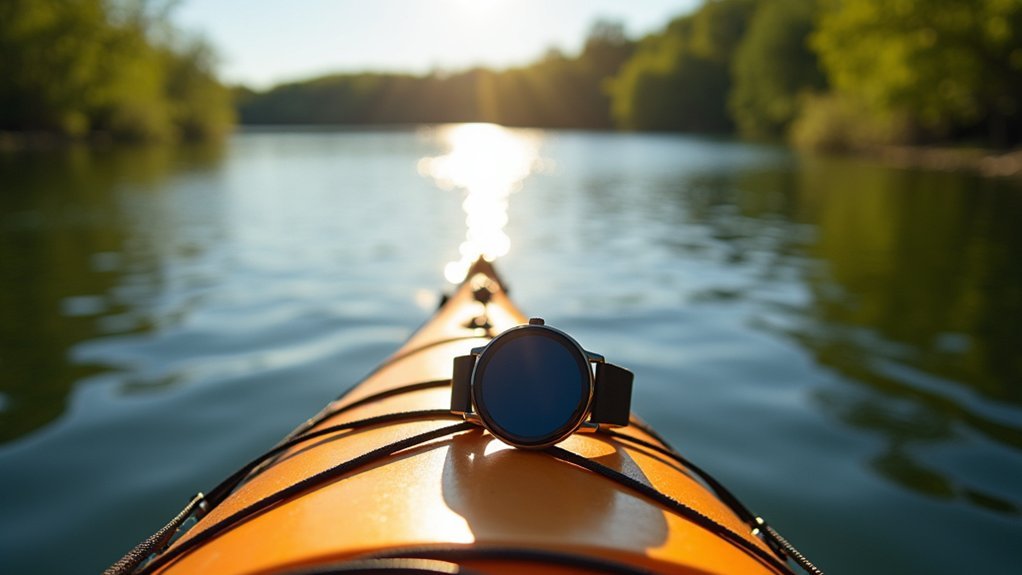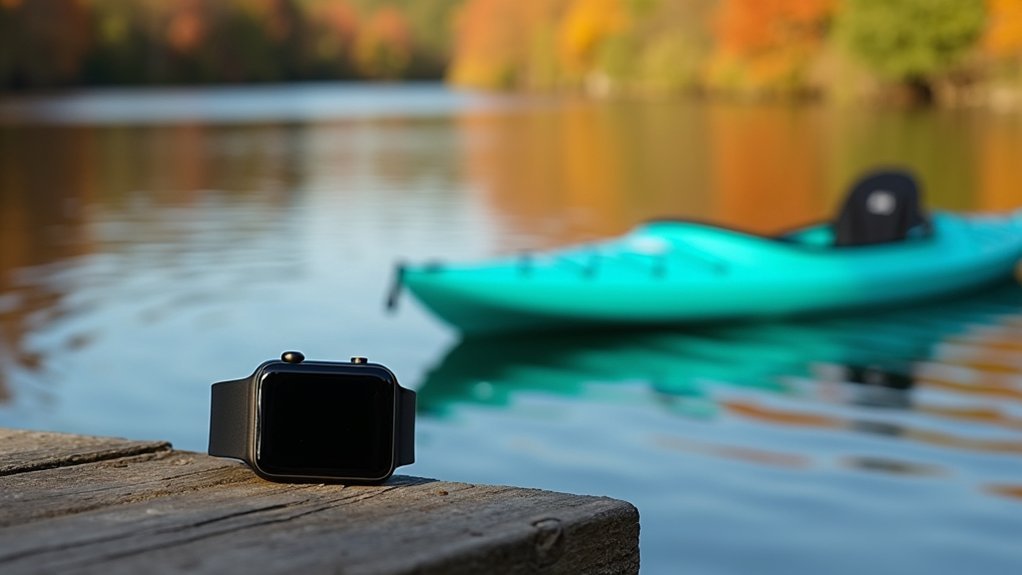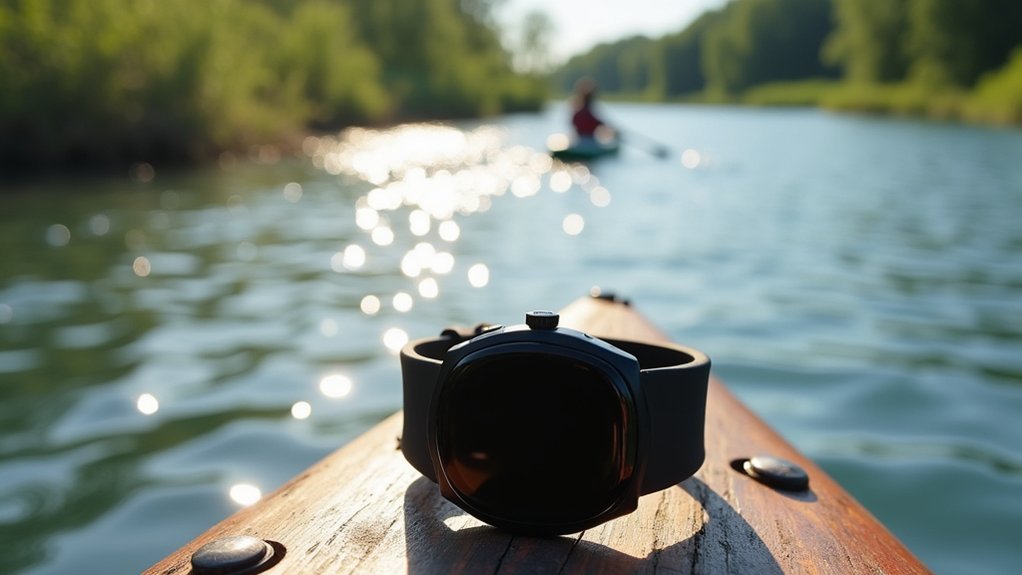To maximize your kayaking GPS watch accuracy, position the device above water level on your wrist or kayak deck. Enable multiple satellite systems (GPS, GLONASS, Galileo) for better tracking. Adjust stroke detection settings to match your paddling style and water conditions. Use dedicated kayaking or flatwater modes when available. Update firmware regularly for improved performance. Customize sampling rates to balance battery life with tracking precision. These simple adjustments will transform your on-water navigation experience.
Position Your Watch Above Water Level

When kayaking with a GPS watch, the height at which you wear your device dramatically affects tracking accuracy. Keeping your watch elevated above the water surface guarantees clearer satellite communication by preventing signal obstruction.
Water substantially blocks GPS transmission, so even brief submersions can create gaps in your tracking data. Consider mounting your watch on the kayak deck or wearing it higher on your forearm to maintain consistent signal reception. Many experienced kayakers rely on their watches to track their routes which can later be transferred to charts for future navigation planning.
This positioning also minimizes multipath errors caused by signal reflection off the water surface. Each ripple can bounce signals erratically, creating position inaccuracies.
The stability of an above-water position helps your watch’s algorithms process location data more effectively. For ideal results, pair this technique with watches featuring multi-satellite systems like GLONASS or Galileo, which perform best with unobstructed sky views.
Optimize Device Placement to Minimize Interference
Beyond positioning your watch above water level, strategic placement relative to other equipment can dramatically improve GPS accuracy while kayaking.
Keep your GPS watch away from other electronic devices that might cause interference with signal reception.
Electronic devices create interference fields that can disrupt GPS signals, so maintain distance between your watch and other tech equipment.
Don’t let clothing obstruct your device—loose-fitting attire allows signals to pass through unimpeded.
Avoid placing your watch near metal objects like paddles or metal-framed kayaks that can block satellite communication.
If you’re using radios or other transmission equipment, position your GPS watch as far away as possible from these RF sources.
For optimal results, ensure your device can “see” at least four satellites as this is the minimum requirement for accurate positioning.
Consider using a waterproof case that protects your device while maintaining signal integrity.
This simple barrier can prevent water damage without sacrificing the accuracy you need for navigation on the water.
Adjust Sampling Rate for Better Battery Life

When kayaking for extended periods, you’ll need to balance GPS tracking accuracy with battery preservation through strategic sampling rate adjustments.
You can customize your GPS watch’s interval mode settings to reduce power consumption without sacrificing critical tracking data during your paddling adventure.
Most advanced GPS watches offer activity-specific profiles that let you toggle between high-accuracy tracking for technical waterways and power-saving modes for straightforward routes.
For optimal performance during water activities, consider the Garmin Enduro 3 with its solar charging capabilities that can significantly extend battery life during long kayaking expeditions.
Balance Tracking vs. Duration
Finding the perfect balance between tracking accuracy and battery life represents one of the biggest challenges for kayakers using GPS watches.
You’ll need to prioritize essential GPS tracking over secondary features like heart rate monitoring for longer expeditions.
Consider adjusting your watch’s sampling rate—lower rates consume less power but provide less detailed tracking data.
For extended trips, use power-saving modes that still maintain adequate navigation accuracy.
Watches with solar charging, like the Garmin Instinct 2 Solar, can dramatically extend your tracking duration.
Remember to disable unnecessary features such as Bluetooth, Wi-Fi, and notifications when on the water.
Plan routes with fewer turns to reduce GPS recalculations, and utilize preset ultra-low power modes when available.
These strategies help you maintain critical tracking capabilities throughout your entire kayaking adventure.
Many paddlers report that Garmin models offer more accurate on-water speed tracking compared to multifunctional alternatives.
Interval Mode Settings
Although many kayakers focus on choosing the right GPS watch model, understanding interval mode settings can dramatically improve battery life while maintaining necessary accuracy. Adjusting your GPS sampling rate creates the perfect balance between tracking precision and power consumption during your paddling sessions. For optimal results, you can customize your watch by selecting specific interval types in the training menu.
| Sampling Rate | Accuracy | Battery Impact |
|---|---|---|
| Every 1 second | High tracking detail | Drains quickly |
| Every 5 seconds | Moderate accuracy | Balanced usage |
| Ultratrac mode | Basic route only | Maximum duration |
For open-water paddling with consistent speed, lower sampling rates work well. Switch to higher rates during technical maneuvers or when guiding through narrow waterways. Most Garmin watches allow you to customize these settings within saved workouts. Try creating separate profiles—high sampling for short trips and reduced frequency for all-day adventures.
Enable Multiple Satellite Systems for Enhanced Accuracy
Since modern GPS watches provide access to multiple satellite constellations, you’ll greatly boost tracking accuracy by enabling all available systems rather than relying on GPS alone.
Multi-system tracking combines GPS with GLONASS, Galileo, and BeiDou to reduce positioning errors to as low as 1.74 meters.
Navigate to your watch’s GPS settings and activate all available satellite systems. This improvement comes with a slight battery trade-off, but the enhanced accuracy is essential for kayaking where small positional deviations impact route and speed measurements.
With more satellites visible simultaneously, your watch maintains better positioning even when tree cover or waves obstruct signals.
Multi-constellation tracking also improves satellite geometry, minimizing uncertainty in your position and providing more reliable speed readings on the water.
However, most sports watches can only track two GNSS systems simultaneously, so prioritize the combinations that work best in your kayaking environment.
Calibrate Stroke Detection Settings Before Paddling

Properly calibrating your GPS watch’s stroke detection settings before hitting the water will dramatically improve your kayaking metrics.
You’ll need to adjust sensitivity thresholds to match your specific paddling style, kayak type, and water conditions for maximum accuracy.
This pre-paddle calibration guarantees your watch correctly counts strokes and calculates distance per stroke, giving you reliable data for performance analysis.
Many paddlers find that models like the Garmin Forerunner series and NK Speedcoach offer superior instant speed readout capabilities when properly calibrated for paddling activities.
Calibrate Stroke Detection Settings Before Paddling
Before heading out on the water, you’ll need to calibrate your GPS watch’s stroke detection settings to guarantee accurate paddling metrics. Take a few minutes to adjust settings to match your personal stroke dynamics—it’ll pay off with more reliable data.
Ensure all sensors are properly calibrated to track your movements accurately during each stroke phase. Position your watch securely on your wrist to prevent shifting during paddling, as consistent placement dramatically improves detection accuracy.
Consider conducting brief test sessions at varying intensities to help the system learn your paddling pattern. Maintain a consistent stroke rate during these tests to allow the algorithm to better recognize your technique.
Your watch will adapt over time, resulting in increasingly precise measurement of both stroke rate and distance per stroke. Accurate tracking of these metrics allows you to calculate your speed in mph, which is a crucial performance indicator in canoe racing.
Personalize Sensitivity Thresholds
Fine-tuning your GPS watch’s sensitivity thresholds represents a crucial step that many paddlers overlook. You’ll get more accurate stroke counts and cadence data when you adjust settings to match your specific paddling style and environment.
| Water Condition | Recommended Sensitivity | Expected Outcome |
|---|---|---|
| Calm Lake | Medium | Precise stroke count |
| Choppy Ocean | Low | Fewer false positives |
| River Rapids | Medium-Low | Better motion filtering |
| Slow Touring | Medium-High | Captures gentle strokes |
| Race Pace | High | Detects quick strokes |
Don’t settle for default settings that might miss legitimate strokes or count false ones. If your watch allows custom calibration, test different thresholds during practice sessions. For devices with limited options, select the activity mode that best resembles your paddling intensity and water conditions. Many users have expressed disappointment because of the missing stroke fields in standard kayak activity tracking apps.
Select Appropriate Activity Modes for Kayaking
When you’re looking to maximize your GPS watch’s accuracy on the water, choosing the right activity mode makes all the difference.
Always select dedicated “Kayaking,” “SUP,” or “Flatwater” modes instead of generic running or cycling profiles, as these are calibrated specifically for paddling movements and water conditions.
For calm lakes or rivers, use “Flatwater Mode” to capture consistent stroke metrics and distance.
Switch to “Whitewater Mode” when tackling rapids to better track elevation changes and dynamic movements.
These specialized modes adjust GPS algorithms to account for water reflections and your unique paddling pattern.
If your watch lacks a kayaking-specific mode, choose the closest alternative like SUP, which still prioritizes stroke-based measurements over step counts or cycling cadence.
For adventure racing events that include kayaking segments, remember that the Adventure Race activity mode operates without displaying maps or tracks as electronic navigation aids are not permitted during competitions.
Update Firmware and Maps Regularly
Keeping your kayaking GPS watch updated with the latest firmware and maps represents one of the most overlooked yet critical factors in maintaining accurate readings on the water.
These updates deliver bug fixes and enhanced positioning algorithms that greatly reduce location errors and drift while paddling.
Always download updates over reliable Wi-Fi connections and keep your device charged above 50% during installation to prevent corruption.
Before major trips, check for updates through your manufacturer’s official app or website. After updating, restart your watch to properly initialize the new software.
Regular updates guarantee you’ll benefit from improved satellite lock-on times, current shoreline details, and kayak-specific tracking metrics.
You’ll also gain access to valuable features like weather overlays and hazard warnings that enhance both navigation accuracy and on-water safety.
Previous iOS app syncs with your Fenix device can streamline the update process and ensure your GPS data transfers seamlessly.
Frequently Asked Questions
Can GPS Watches Accurately Track Distance in Tidal or Current-Affected Waters?
GPS watches track your distance over ground, not through water. In tidal waters, they won’t accurately reflect your paddling effort as they can’t distinguish between your propulsion and current effects.
How Do I Waterproof My GPS Watch for Kayaking?
Choose a watch with at least IP68 or 100m water resistance rating. Don’t press buttons underwater, use a protective case, and secure it with a tether. Rinse with fresh water after kayaking and inspect seals regularly.
Will My GPS Watch Work in Remote Wilderness Water Bodies?
Yes, your GPS watch will work in remote wilderness waters. You’ll get best results with multi-GNSS support, clear sky visibility, and proper positioning on your wrist or kayak to keep it above water.
Can My Watch Detect Kayak Capsizing or Emergency Situations?
Some watches can detect capsizing through fall detection and accelerometers. You’ll need a model with waterproofing and emergency features. Apple Watch Ultra or devices with Paddle Logger app offer the best protection during emergencies.
How Accurate Are Calorie Calculations During Kayaking Activities?
Calorie calculations during kayaking are typically less accurate than for land activities. Your watch may underestimate by 20-40% due to unreliable heart rate tracking and algorithms not optimized for paddling movements and water resistance.
In Summary
You’ll see a dramatic improvement in your kayaking GPS accuracy by implementing these simple techniques. Keep your watch above water, minimize interference, and adjust your sampling rate to balance precision with battery life. Don’t forget to enable multiple satellite systems, calibrate your stroke detection, use the proper activity mode, and maintain updated firmware. With these adjustments, you’re set for more accurate tracking during every paddling adventure.





Leave a Reply